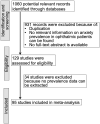The prevalence of anxiety symptoms and disorders among ophthalmic disease patients
- PMID: 35464342
- PMCID: PMC9021519
- DOI: 10.1177/25158414221090100
The prevalence of anxiety symptoms and disorders among ophthalmic disease patients
Abstract
Background: Progressive and irreversible vision loss has been shown to place a patient at risk of mental health problems such as anxiety. However, the reported prevalence of anxiety symptoms and disorders among eye disease patients vary across studies. Thus, this study aims to clarify the estimated prevalence of anxiety symptoms and disorders among ophthalmic disease patients.
Methods: Relevant studies on the prevalence of anxiety symptoms and disorders among eye disease patients were collected through international databases, PubMed, Scopus, and Web of Science. A random-effects model was used to determine the pooled prevalence of anxiety symptoms and disorders among ophthalmic disease patients.
Results: The 95 included studies yielded a pooled prevalence of 31.2% patients with anxiety symptoms and 19.0% with anxiety disorders among subjects with ophthalmic disease. Pediatric patients were more anxious (58.6%) than adults (29%). Anxiety symptoms were most prevalent in uveitis (53.5%), followed by dry eye disease (DED, 37.2%), retinitis pigmentosa (RP, 36.5%), diabetic retinopathy (DR, 31.3%), glaucoma (30.7%), myopia (24.7%), age-related macular degeneration (AMD, 21.6%), and cataract (21.2%) patients. Anxiety disorders were most prevalent in thyroid eye disease (TED, 28.9%), followed by glaucoma (22.2%) and DED (11.4%). When compared with healthy controls, there was a twofold increase on the prevalence of anxiety symptoms (OR = 1.912, 95% CI 1.463-2.5, p < 0.001) and anxiety disorders (OR = 2.281, 95% CI 1.168-4.454, p = 0.016).
Conclusion: Anxiety symptoms and disorders are common problems associated with ophthalmic disease patients. Thus, comprehensive and appropriate treatments are necessary for treating anxiety symptoms and disorders among ophthalmic disease patients.
Keywords: anxiety symptoms and disorders; ophthalmic disease; prevalence.
© The Author(s), 2022.
Conflict of interest statement
Conflict of interest statement: The authors declared no potential conflicts of interest with respect to the research, authorship, and/or publication of this article.
Figures








Similar articles
-
[Prevalence of ophthalmic diseases in the population older than 50 years].Vestn Oftalmol. 2020;136(3):106-115. doi: 10.17116/oftalma2020136031106. Vestn Oftalmol. 2020. PMID: 32504485 Russian.
-
The Prevalence of Depression and Depressive Symptoms among Eye Disease Patients: A Systematic Review and Meta-analysis.Sci Rep. 2017 Apr 12;7:46453. doi: 10.1038/srep46453. Sci Rep. 2017. PMID: 28401923 Free PMC article.
-
Dry eye disease and psychiatric disorders: A systematic review and meta-analysis.Eur J Ophthalmol. 2022 Jul;32(4):1872-1889. doi: 10.1177/11206721211060963. Epub 2021 Dec 22. Eur J Ophthalmol. 2022. PMID: 34935549 Free PMC article.
-
Major sight-threatening eye disorders and mental disorders.Acta Ophthalmol. 2025 May;103(3):257-271. doi: 10.1111/aos.16800. Epub 2024 Nov 26. Acta Ophthalmol. 2025. PMID: 39588880
-
Metabolomics studies in common multifactorial eye disorders: a review of biomarker discovery for age-related macular degeneration, glaucoma, diabetic retinopathy and myopia.Front Mol Biosci. 2024 Aug 13;11:1403844. doi: 10.3389/fmolb.2024.1403844. eCollection 2024. Front Mol Biosci. 2024. PMID: 39193222 Free PMC article. Review.
Cited by
-
The Narrative Medicine Approach in the Treatment of Diabetic Macular Edema: An Italian Experience.Int J Environ Res Public Health. 2022 Jul 30;19(15):9367. doi: 10.3390/ijerph19159367. Int J Environ Res Public Health. 2022. PMID: 35954724 Free PMC article.
-
The association between cataract surgery and mental health in older adults: a review.Int J Surg. 2024 Apr 1;110(4):2300-2312. doi: 10.1097/JS9.0000000000001105. Int J Surg. 2024. PMID: 38668662 Free PMC article. Review.
-
Research on the Anxiety and Depression of Patients with Mechanical Ocular Injuries: A Cross-Sectional Study.Psychol Res Behav Manag. 2025 Jan 15;18:81-90. doi: 10.2147/PRBM.S485854. eCollection 2025. Psychol Res Behav Manag. 2025. PMID: 39834482 Free PMC article.
-
Bidirectional link between mood disorders and diabetic retinopathy.World J Psychiatry. 2025 May 19;15(5):102540. doi: 10.5498/wjp.v15.i5.102540. eCollection 2025 May 19. World J Psychiatry. 2025. PMID: 40495843 Free PMC article.
-
[1H-13C]-NMR-Based Metabolic Kinetics Reveals Brain Neurochemical Alterations in Mice After Retinal Ischemia-Reperfusion Injury.Mol Neurobiol. 2025 May;62(5):5758-5773. doi: 10.1007/s12035-024-04641-3. Epub 2024 Dec 2. Mol Neurobiol. 2025. PMID: 39621232
References
-
- Baxter AJ, Scott KM, Vos T, et al.. Global prevalence of anxiety disorders: a systematic review and meta-regression. Psychol Med 2013; 43: 897–910. - PubMed
LinkOut - more resources
Full Text Sources

